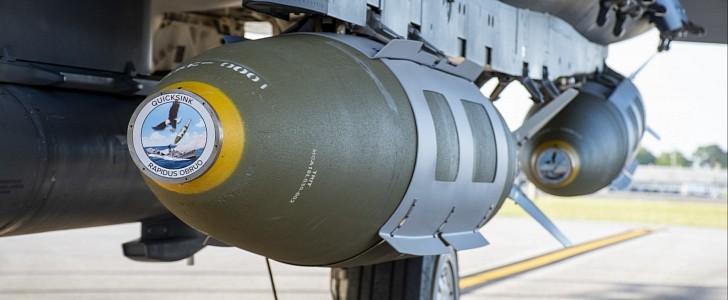A few days ago, U.S. military officials and their industry partners watched a surface vessel get destroyed in the Gulf of Mexico, not by a classic torpedo launched by a submarine, but by a new-generation bomb dropped from the sky. It was the second successful test of Quicksink.
Despite its chipper commercial name, this program is testing a deadly threat for all warships. The infamous sinking of Russia’s flagship military vessel in the conflict with Ukraine has confirmed once again the crucial importance of defense capabilities against maritime threats.
According to the U.S. military, a Navy submarine can destroy any warship with a single torpedo. But it’s not cheap, and it’s got its limitations.
The Air Force Research Laboratory (AFRL) has been working on an alternative method that would be low-cost while having the same success rate of a torpedo over even wider areas. It’s officially called the QUICKSINK Joint Capability Technology Demonstration, and the first successful test was completed last year.
During this second test, an F-15E Strike Eagle launched a modified GBU-31 Joint Direct Attack Munition (JDAM), obliterating a mock enemy full-scale vessel. At the moment, only a small percentage of the Navy can effectively launch heavy-weight torpedoes against military ships.
With this new capability, USAF’s combat aircraft could also destroy ships by using air-launched weapons. The modified 2,000-pound (907 kg) JDAM precision-guided bombs are the deadliest ones. As a result, the armed forces’ overall anti-ship lethality would be increased exponentially.
The main advantage of using this new capability is that it can “rapidly deliver an immediate effect on stationary or moving maritime targets at minimal costs.” A part of the reason for that is the AFRL-developed “weapon open systems architecture.” This combines a modular structure with a precise placement of the weapon, resulting in higher efficiency and reduced costs.
As warships become even more sophisticated, effective anti-ship methods must also evolve, and Quiksink will make enemy vessels look fearfully to the sky instead of underwater.
According to the U.S. military, a Navy submarine can destroy any warship with a single torpedo. But it’s not cheap, and it’s got its limitations.
The Air Force Research Laboratory (AFRL) has been working on an alternative method that would be low-cost while having the same success rate of a torpedo over even wider areas. It’s officially called the QUICKSINK Joint Capability Technology Demonstration, and the first successful test was completed last year.
During this second test, an F-15E Strike Eagle launched a modified GBU-31 Joint Direct Attack Munition (JDAM), obliterating a mock enemy full-scale vessel. At the moment, only a small percentage of the Navy can effectively launch heavy-weight torpedoes against military ships.
With this new capability, USAF’s combat aircraft could also destroy ships by using air-launched weapons. The modified 2,000-pound (907 kg) JDAM precision-guided bombs are the deadliest ones. As a result, the armed forces’ overall anti-ship lethality would be increased exponentially.
The main advantage of using this new capability is that it can “rapidly deliver an immediate effect on stationary or moving maritime targets at minimal costs.” A part of the reason for that is the AFRL-developed “weapon open systems architecture.” This combines a modular structure with a precise placement of the weapon, resulting in higher efficiency and reduced costs.
As warships become even more sophisticated, effective anti-ship methods must also evolve, and Quiksink will make enemy vessels look fearfully to the sky instead of underwater.






